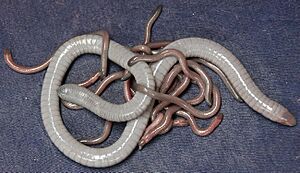Herpele squalostoma facts for kids
Quick facts for kids Herpele squalostoma |
|
|---|---|
 |
|
| Female (36 cm (14 in) long) with young | |
| Conservation status | |
| Scientific classification | |
| Genus: |
Herpele
|
| Species: |
squalostoma
|
| Synonyms | |
|
Caecilia squalostoma Stutchbury, 1836 |
|
The Herpele squalostoma is a type of animal called a caecilian. It belongs to the family Herpelidae. People also call it the Congo caecilian. You can find this interesting creature in Central and the far eastern part of West Africa. This includes countries like southeastern Nigeria, Cameroon, Gabon, and the Republic of the Congo.
Description
The Congo caecilian has a body shaped like a cylinder. It can grow to be about 41 centimeters (16 inches) long. Its body is usually about 6 to 8 millimeters (0.24 to 0.31 inches) wide. It has a snout that sticks out.
One unique thing about this animal is its eyes. They are covered by bone, so you cannot see them from the outside. The caecilian's body has many rings, like a worm. These rings are called annuli. The animal is usually dark olive green. It also has tiny yellowish spots all over its body.
Reproduction and Life Cycle
Female Congo caecilians take great care of their young. One mother, about 36 centimeters (14 inches) long, was found with 16 babies. She was in moist soil, about 10 centimeters (3.9 inches) below the ground. The young caecilians were about 11 to 12 centimeters (4.3 to 4.7 inches) long.
Like other animals in its family, the Herpele squalostoma probably lays eggs. The largest eggs found for this species are about 3.5 by 2.6 millimeters.
Special Parental Care H. squalostoma mothers have a very special way to feed their babies. They grow an extra layer of skin on their bodies. Their young then eat this skin. This process is called maternal dermatophagy. It helps the babies get important nutrients. It also helps them get helpful bacteria from their mother's body. The young caecilians become independent when they grow to be about 10 to 12 centimeters (3.9 to 4.7 inches) long.
Habitat and Conservation
The Herpele squalostoma lives in lowland forests. You can also find it in places where fruit trees are grown, in gardens, and in forests that have grown back after being cut down. It can live at least up to 800 meters (2,600 feet) above sea level in Cameroon. This caecilian mostly lives underground, digging tunnels.
Threats and Protection Sometimes, these caecilians are sold as pets. However, it is not known if this is a big threat to their numbers. A fungus called Batrachochytrium dendrobatidis has been found in this species. This fungus causes a disease called chytridiomycosis, which can be a danger to amphibians.
Luckily, the Herpele squalostoma lives in many protected areas. These include the Korup National Park in Cameroon and the Moukalaba-Doudou National Park in Gabon. These protected areas help keep the species safe.


